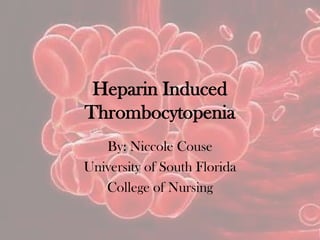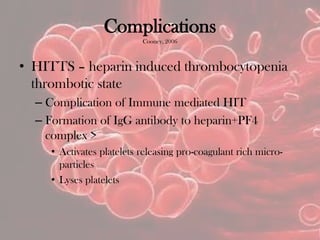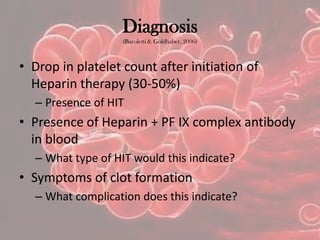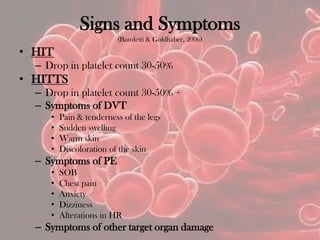N.couse case study_hit
- 1. Heparin Induced Thrombocytopenia By: Niccole Couse University of South Florida College of Nursing
- 2. Introduction Baroletti & Goldhaber, 2006 âĒ Heparin Induced Thrombocytopenia is a complication of Heparin therapy that leads to decreased levels of platelets in the blood. âĒ Two types â Immune mediated âĒ DANGEROUS âĒ Rare â Non-Immune mediated âĒ Self limited âĒ Common
- 3. Heparin Mechanism of Action âĒ Most common anti-coagulant used in the hospital setting. (Cooney, 2006) âĒ Does not normally affect platelets directly (Baroletti & Goldhaber, 2006) âĒ Binds with anti-thrombin to increase itâs efficacy of inhibiting â Thrombin â Platelet factor Xa â Platelet factor IXa â Platelet factor XIIa (Krishnaswamy, Lincoff & Cannon, 2010)
- 4. Normal Heparin Side Effects (Deglin, Vallerand & Sanoski, 2012) âĒ Signs/symptoms of bleeding â Bruising or blackening âĒ Around injection site âĒ On fingers, toes and nipples â Bleeding gums â Nose bleeds â Hematuria â Melena â Hypotension â Decreased H&H
- 5. HIT Pathophysiology Cooney, 2006 Immune mediated âĒ Generally presents within 5â14 days of heparin administration âĒ Drop of platelet count by 30- 50% âĒ Requires treatment â can be fatal âĒ Immune response to heparin and platelet factor IX complex â Often leading to thrombosis Non-Immune mediated âĒ Presents within 5 days of heparin administration âĒ Minimal drop in platelet count âĒ Will generally resolve on own â Continued exposure debated âĒ Does not result in bleeding or thrombosis
- 6. Incidence Cooney, 2006 âĒ Heparin widely used in hospitalized patients â 1/3 or about 12 million annually âĒ % of patients that will develop HIT â Non-Immune mediated ~ 10% â Immune mediated ~ 5%
- 7. Risk Factors Cooney, 2006 âĒ Unfractionated Heparin use â LMW heparin is safer âĒ IV heparin use â Sub Q is safer âĒ Orthopedic, cardiovascular & trauma patients â Cardiovascular patientsâ more at risk for arterial thrombi â Orthopedic & trauma patients â more at risk for venous thrombi
- 8. Complications Cooney, 2006 âĒ HITTS â heparin induced thrombocytopenia thrombotic state â Complication of Immune mediated HIT â Formation of IgG antibody to heparin+PF4 complex > âĒ Activates platelets releasing pro-coagulant rich micro- particles âĒ Lyses platelets
- 9. HITTS Cooney, 2006 âĒ Dangerous complication of Immune mediated HIT â 38-76% âĒ Characterized by excessive clotting in the blood. âĒ Clots can travel throughout the body causing harm. â DVT 50% â PE 25% â Limb necrosis 20% â Death â Other target organ damage âĒ Stroke, MI, ARF, etc.
- 10. Diagnosis (Baroletti & Goldhaber, 2006) âĒ Drop in platelet count after initiation of Heparin therapy (30-50%) â Presence of HIT âĒ Presence of Heparin + PF IX complex antibody in blood â What type of HIT would this indicate? âĒ Symptoms of clot formation â What complication does this indicate?
- 11. Signs and Symptoms (Baroletti & Goldhaber, 2006) âĒ HIT â Drop in platelet count 30-50% âĒ HITTS â Drop in platelet count 30-50% + â Symptoms of DVT âĒ Pain & tenderness of the legs âĒ Sudden swelling âĒ Warm skin âĒ Discoloration of the skin â Symptoms of PE âĒ SOB âĒ Chest pain âĒ Anxiety âĒ Dizziness âĒ Alterations in HR â Symptoms of other target organ damage
- 12. Assessment âĒ Be aware! âĒ Closely monitor patients on Heparin therapy â Monitor platelet count âĒ Normal? â Monitor PTT, PT, INR â Monitor for S/S of bleeding and clotting
- 13. Treatment (Cooney, 2006) âĒ STOP HEPARIN!! âĒ Begin other approved anticoagulant â Direct thrombin inhibitors âĒ Argatroban & Lepirudin âĒ Block activation of thrombin and do not trigger antibody- mediated reactions âĒ Symptom management âĒ Warfarin can be started after treatment and platelet count reaches minimum of 100,000
- 14. Treatments â nursing considerations âĒ Monitor daily INR âĒ Reduce thrombosis â Anti-embolism stockings â Increase activity/exercise âĒ Ambulation â Hydration âĒ Careful observation
- 15. Prognosis âĒ Highest mortality rate in Immune-mediated HIT âĒ 6-10% mortality (Ecke & May, 2012) â DVT 50% â PE 25% â Limb necrosis 20% â Death (Cooney, 2006)
- 16. Nursing Diagnosis âĒ Risk for â Ineffective tissue perfusion â Ineffective gas exchange â Decreased cardiac output â Acute renal failure â Altered mental status â Etc.
- 17. Clinical Example âĒ HPI: Patient 73 year old male admitted to the hospital with a C.C. of shortness of breath. Diagnosed with new onset A.fib and received cardioversion to sync back to NSR. Pateint received a TEE revealing severe mitral valve calcification and regurgitation. He was scheduled for a cath but elected to go home until the surgery due to breathing much better.
- 18. Clinical Example âĒ Patient came back early due to SOB and remained hospitalized until the surgery. He received a CAGB X1 and MV replacement. He received Heparin during the surgery. (1st use)
- 19. Clinical Example Complications â âĒ 6 days post op he began experiencing increasing SOB â received a CT that identified small bilateral PEs. Also became acutely confused âĒ His platelet level dropped to 94,000 âĒ In the following days he began exhibiting signs of â Acute renal failure (elevated BUN and Creatnine and anuria) â Poor tissue perfusion (R foot: molten toes, cool skin and diminished pulses) â Liver damage (liver function tests diminished)
- 20. Relating to the Patient âĒ Pulmonary embolisms âĒ Acute confusion âĒ Arterial embolism in the R leg? âĒ ARF requiring dialysis âĒ Liver function decline
- 21. NCLEX style question âĒ TRUE or FALSE? âAll patients that develop HIT will experience thrombosis?
- 22. NCLEX style question âĒ TRUE or FALSE? âAll patients that develop HIT will experience thrombosis? FALSE
- 23. NCLEX style question âĒ A patient is started on a Heparin subQ injections daily. You begin to notice bruising around the injection site. You attribute this finding to âĶ. a) HITTS b) Expected side effect of Heparin therapy c) Possible physical abuse d) Allergy to alcohol wipes
- 24. NCLEX style question âĒ A patient is started on a Heparin subQ injections daily. You begin to notice bruising around the injection site. You attribute this finding to âĶ. a) HITTS b) Expected side effect of Heparin therapy c) Possible physical abuse d) Allergy to alcohol wipes
- 25. Questions?
- 26. References âĒ Baroletti, S.A. & Goldhaber, S.Z. (2006) Heparin induced thrombocytopenis. Journal of the American Heart Association. DOI:10.1161/âCIRCULATIONAHA.106.632653 âĒ Cooney, M.F. (2006) Heparin induced thrombocytopenia: Advances in diagnosis and treatment. Critical Care Nurse, 26(6). Retrieved from http://ccn.aacnjournals.org/content/26/6/30.full.pdf+html
- 27. References âĒ Deglin, Vallerand & Sanoski (2012) Davis drug guide âĒ Ecke, S. & May, S.K. (2012) Geparin induced thrombocytopenia follow-up. Retrieved from http://emedicine.medscape.com/article/1357846- followup#a2650 âĒ Krishnaswamy, A. Lincoff, M., & Cannon, C.P. (2010) The use and limitations of unfractioned heparin. Critical Pathways in Cardiology 9(1) Retrieved from http://www.automedicsrx.com/publications/The_Use_and_Limit ations_of_Unfractionated_Heparin.pdf


























